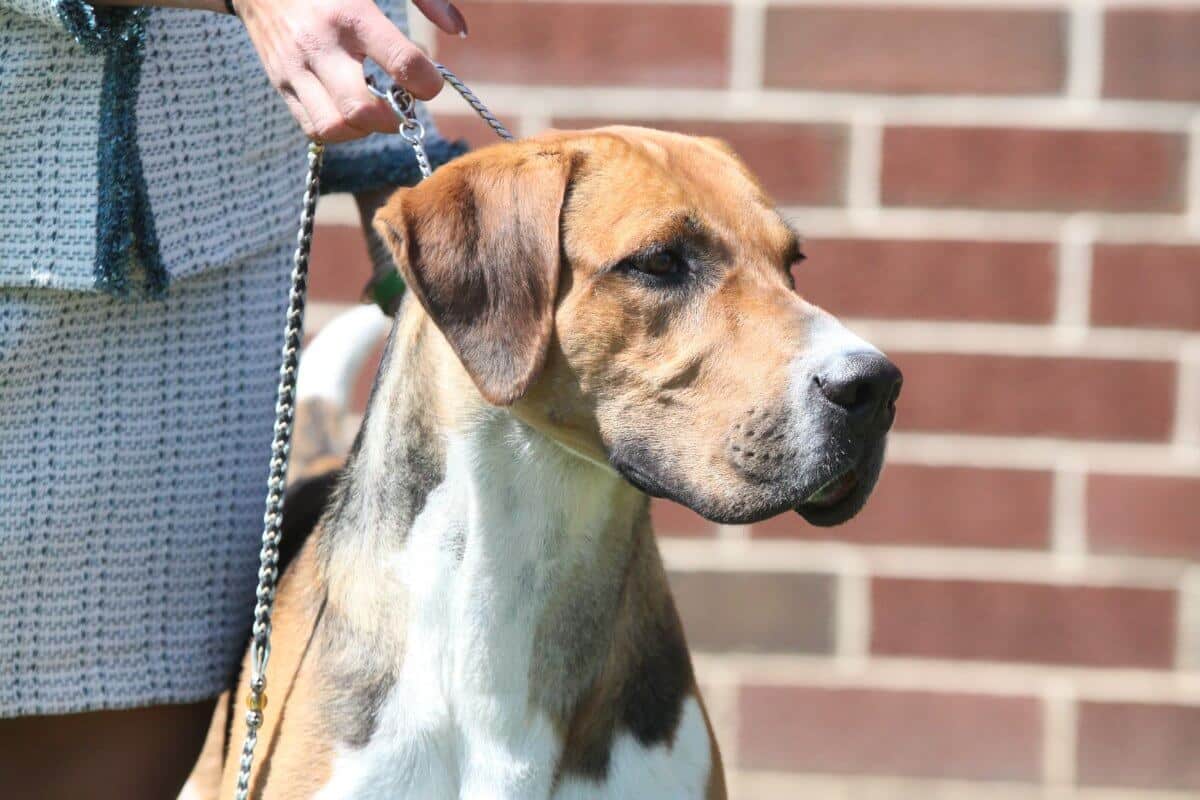
Toni Koerber | Monocacy Bend Kennels
Toni Koerber is the breeder behind Monocacy Bend Kennels. Read about the kennel’s beginnings, the sires, the dams, the puppies, and more!

Home » Dog Breeds » English Foxhound Dog Breed




The English Foxhound is an iconic breed, renowned for its role in the traditional British sport of foxhunting. With its muscular body, keen sense of smell, and unyielding endurance, this breed has played a pivotal role in country life for centuries. Beyond the hunt, however, this foxhound is also a devoted and friendly companion, boasting a storied lineage that dates back to the 16th century in England.
Hound
24 Inches
60 – 75 Pounds
10 – 13 Years
| Country of Origin | England |
|---|---|
| Bred For | Fox Hunting |
| Known For | Great Stamina, Friendliness, Hunting in Packs |
| Popularity | Low |
| Temperament | Sociable, Affectionate, Gentle |
| Activities | Pack Hunting, Running, Conformation Shows, Dog Sports |
The tale of the English Foxhound begin in the picturesque English countryside, with the breed’s narrative in step with the nation’s fox hunting tradition.
The breed’s roots trace back to ancient hounds in England that were used for hunting as far back as the Roman era. By the later medieval period, selective breeding for hunting prowess was becoming more systematic. Influences from breeds such as the Staghound and Harrier laid the foundation for the modern English Foxhound.
Purposefully bred for the sport of fox hunting, a revered pastime among the aristocracy, the English Foxhound was developed with specific traits in mind. The hounds needed the stamina to cover vast distances in pursuit of foxes, and an acute sense of smell to track their quarry. Furthermore, the hounds’ distinctive bark, tuneful and clear, allowed the hunters to keep tabs on the chase, even when the hounds were out of sight.
In recognition of their storied heritage and breed purity, several major canine organizations have given the English Foxhound their official stamp of approval. The American Kennel Club granted recognition in 1909, with both the Fédération Cynologique Internationale and The Royal Kennel Club in the UK doing likewise.
Although the fervor for fox hunting has diminished in recent years due to changing societal views and legislative measures, the breed’s legacy remains unblemished. While English Foxhound’s presence in the countryside is less common today, they are still treasured for their affable nature, unwavering loyalty, and the vibrant history they represent.
Mature English Foxhounds typically stand at 24 inches tall at the shoulder.
In terms of weight, adult English Foxhounds usually weigh between 60 and 75 pounds.
The English Foxhound has a body that exudes power and endurance. Its structure is slightly elongated, with the body length being just greater than its height. This proportion provides the dog with the balance and stability needed to hunt without tiring. The substance of this breed is neither coarse nor light; rather, the English Foxhound displays a well-rounded musculature, indicative of its innate strength and stamina.
Texture: The English Foxhound sports a coat that’s short and dense, providing the hound with adequate protection against the rigors of a day’s hunt. The coat is neither too coarse nor too fine, and it has a somewhat hard texture to shield the skin from brush and thorns during the chase.
| Standard Color | |
|---|---|
| Black White & Tan | ee |
| Lemon & White | ee |
| White | ee |
Markings: Pie
A Note About Color: The color of the short, dense coat of the English Foxhound is largely considered unimportant; however, any good “hound color” would include black, tan, and white, and various “pies,” which are an amalgam of white and the color of the hare or badger, or tan, or yellow.
The tail, also referred to as the “stern,” is set moderately high and follows the column of the spine at its base. It is carried gaily but not curled over the back. In terms of length, it reaches the hocks and possesses a slight curve, giving it an elegant appearance.
When the hound is in motion, especially during a chase, the tail’s movement is lively, signaling enthusiasm and zeal. When at rest, the tail is relaxed but remains poised, showcasing the breed’s ever-ready nature.
The tail’s coat is short and dense, like that on the rest of the body, and is finished with a “flag” of longer hairs underneath. This offers protection from the elements and the rough terrain over which this noble hound hunts.
The decision to own an English Foxhound, like any dog, requires careful consideration. This breed, historically employed in the traditional sport of foxhunting, brings with it a unique set of characteristics, demands, and joys. From the hound’s physical needs to its temperament, understanding what it means to have an English Foxhound as a part of a family lifestyle will support a harmonious relationship for years to come.
Generally speaking, the English Foxhound is a robust dog, benefitting from centuries of selective breeding to ensure these hounds are up to the physical demands of the hunt. This has led to a breed with a strong constitution and fewer inherited health problems than many other breeds.
Lifespan: The average lifespan is between 10 to 13 years. Providing a balanced diet, regular vet check-ups, and adequate exercise can help to promote a longer, healthier life.
While the English Foxhound is a hardy breed, there are certain health risks that potential owners should be aware of:
Early detection and proactive care can offer the English Foxhound a long, healthy, and active life. Regular veterinary visits, a balanced diet, and an active lifestyle are all key components for supporting the hound’s overall well-being.
The English Foxhound, while bred for the chase, possesses a temperament that is as affectionate as it is determined. Understanding the many facets of this breed’s personality will help potential owners to foster a fulfilling relationship with their four-legged Foxhound.
These Foxhounds have a moderate degree of sensitivity, thriving on doggy companionship and often reflecting the emotions of their human caretakers. Their training calls for a mix of firmness balanced with a gentle touch, ensuring the hounds understand their role within the family dynamic.
Despite the breed’s sociable nature, these hounds can typically handle short periods of solitude. However, it is crucial to make sure they aren’t left alone for extended durations, as this can usher in bouts of boredom and sometimes even lead to destructive behaviors.
In the company of other dogs, English Foxhounds typically flourish. Their lineage, rooted in pack hunting, has conditioned them to appreciate and thrive in the company of other canines, particularly if they’ve been familiarized with their packmates from a tender age.
For families with children, the good news is that these hounds are generally patient and interact well with younger members of the household. As always, fostering mutual respect between the children and the hounds will generally lead to a peaceful coexistence.
The English Foxhound’s reactions to strangers can be varied. While certain hounds may lean towards being more reserved, others can be expected to greet unfamiliar faces with warmth and affection. This distinction underscores the importance of early socialization, helping each hound to develop the most gregarious temperament possible.
The dietary needs of the English Foxhound are integral to its well-being, both in maintaining optimal health and in supporting its spirited nature. The breed’s nutritional requirements can vary based on age, activity level, and overall health.
For a growing English Foxhound puppy, it’s crucial to provide a balanced diet that supports rapid growth and development. This often means seeking out high-quality puppy formulations that offer a mix of protein, fats, and essential nutrients tailored to their developmental needs.
Transitioning to adulthood, their dietary needs evolve. An adult English Foxhound typically requires a nutritious and well-balanced diet to sustain its energy levels, particularly if the hound is involved in regular physical activity. This generally includes a diet rich in proteins, balanced fats, and all the necessary vitamins and minerals. The exact amount of food can vary, but as a guideline, most English Foxhounds fare well with two to three cups of premium-quality dog food split into two meals a day.
It’s essential to monitor a hound’s weight and adjust food quantities accordingly. Overfeeding or providing too many treats can lead to obesity, which brings its own set of health complications. Conversely, underfeeding or providing a nutritionally deficient diet can lead to various health issues and a decrease in vitality.
Always ensure that fresh water is available, and when making any significant changes to a hound’s diet, do so gradually to prevent digestive upsets.
Lastly, consulting with a veterinarian can provide personalized feeding recommendations tailored to an individual dog’s needs.
Training the English Foxhound requires a blend of patience, consistency, and understanding of the breed’s inherent characteristics. With their strong hunting lineage, these hounds come equipped with a keen nose and an instinctual drive to follow scents, which can sometimes pose challenges in training, especially during their younger, more exuberant years.
These dogs, however, are intelligent and keen to please. When coupled with positive reinforcement methods, such as treats and praise, they often respond well to commands and lessons. Early socialization is a cornerstone for them, ensuring that they develop a balanced temperament and are well-adjusted in various situations, whether around other animals or amidst strangers.
A trait that potential owners should be aware of is the breed’s vocal nature. While not incessantly barky, English Foxhounds do have a distinct and melodic bay which might be used when these hounds catch an interesting scent or when they wish to communicate. Teaching them a “quiet” command early on can help to manage this inclination.
The breed’s natural predation drive is another factor to consider. It’s not uncommon for foxhounds to show a keen interest in smaller animals due to their hunting background. Early training and controlled introductions can help in curbing any overly enthusiastic behaviors towards smaller pets.
In terms of wandering, given their scent-driven nature, English Foxhounds might sometimes be inclined to follow an intriguing smell. Hence, a securely fenced yard or a leash during walks is advisable to make sure they don’t chase after every fascinating aroma.
The English Foxhound, with its historical lineage as a hunting dog, carries an inherent need for regular exercise and mental stimulation. Catering to this requirement not only ensures a healthy physique but also aids in maintaining a balanced temperament.
| Energy Level | Moderate to High |
|---|---|
| Exercise Requirements | 2 Hours/Day (Minimum), Daily Walks, Vigorous Running, Regular Exercise, Playing with Another Dog, Mental Stimulation |
Their exercise needs are pronounced. Being originally bred to chase foxes over long distances, these hounds are blessed with notable stamina and a persistent energy reserve. While some hounds can adjust to a sedate family life, a foxhound certainly thrives best when given ample opportunities to expend its energy, be it through daily walks, play sessions, or other physical activities.
In terms of energy level, the English Foxhound is quite spirited. Individuals of this breed have a strong zest for life and are almost always ready for an adventure. Regular outings, preferably in open spaces where the hound can safely run, are ideal.
One should not mistake the need for exercise as mere physical intensity. While foxhounds are energetic, they aren’t necessarily aggressive in their play. They display a moderate level of playfulness, with some hounds enjoying games like fetch or tug-of-war and other interactive activities.
It’s essential to understand that regular exercise isn’t just about maintaining the English Foxhound’s physical health. It also plays a crucial role in keeping undesirable behaviors at bay. A bored foxhound, especially one that’s cooped up for extended periods, can become restless and resort to destructive habits simply out of boredom.
The English Foxhound, blessed with a sleek and straightforward coat, presents a relatively hassle-free grooming experience for its caretakers. However, regular grooming not only enhances a hound’s aesthetic appeal, it also promotes its overall well-being.
| Coat Type | Short, Dense, Hard, Glossy |
|---|---|
| Grooming Requirements | Weekly Brushing, Occasional Bathing, Routine Ear Cleaning, Periodic Nail Trimming, Regular Tooth Brushing |
The foxhound’s coat is short and dense, protecting it from the elements when the hound is out on a hunting adventure. This type of coat is relatively easy to groom. A weekly brushing with a firm bristle brush should suffice in removing loose hairs and maintaining the natural shine of the coat.
In terms of shedding, English Foxhounds are moderate shedders. Regular brushing helps in managing and reducing the amount of hair that might otherwise find its way onto furniture and clothing. Beyond this, it also serves as an excellent bonding activity and allows owners to check for any skin issues, ticks, or other potential concerns.
Bathing doesn’t need to be frequent, only necessary when the hound gets particularly dirty or starts to develop a doggy odor. Using a mild dog-specific shampoo can ensure that the natural oils on their skin aren’t stripped away.
Other grooming essentials include regular nail trimming, as overgrown nails can cause discomfort or even lead to problems with walking or running. Dental hygiene is crucial too. Brushing the foxhound’s teeth several times a week, or at least providing dental chews, helps in preventing tartar buildup and maintains good oral health.
Ear checks should be a routine part of the grooming process, especially considering the English Foxhound’s hanging ears. Cleaning them as necessary and ensuring they are dry helps with preventing infections and allows any dirt and debris to be easily removed.
Integrating an English Foxhound into one’s living situation requires careful understanding of the breed’s inherent traits and adjusting the environment accordingly.
When it comes to apartment living, it’s not the size of the home but the lifestyle that truly matters. While individual English Foxhounds may be able adapt to apartment life, members of this breed typically need a daily dose of exercise to remain content in such settings. Without adequate physical activity, foxhounds may become restless and potentially exhibit unwanted behaviors. Therefore, potential owners living in apartments or smaller homes must ensure they can provide ample outdoor time for their hounds each and every day.
Weather adaptability is another factor to consider. The foxhound’s dense coat offers a good deal of protection against colder climates. This breed fares reasonably well in colder weather, provided the hounds aren’t exposed to extreme conditions for prolonged periods. During particularly chilly days, a dog coat or sweater can offer added warmth.
Conversely, in hot weather, English Foxhounds can be prone to overheating. It’s essential to always offer access to shade, fresh water, and preferably, a cool indoor environment during peak summer days. Activities during hotter months should ideally be scheduled during the cooler parts of the day, such as early mornings and evenings.
The arrival of a litter of English Foxhound puppies is cause for celebration. Those little bundles of joy, with their playful antics, can seem like they are nothing but fun. There are, however, responsibilities that come with nurturing one of these pups. That boundless energy and insatiable curiosity bring both challenges and fun to a household. So, understanding the developmental needs of a Foxhound puppy is paramount for its transition from puppyhood to adulthood and, more than likely, to life as a pack member.
English Foxhound puppies, like all puppies, require a mix of consistent training, socialization, and proper nutrition to ensure their optimal development. From the moment a puppy steps paw into its new home, it is vital to set boundaries and establish a routine, offering guidance with gentle yet firm instruction. This early stage in the pup’s training sets the foundation for its behavior in the future.
Nutrition is another pivotal aspect of puppy care. Providing the pup with a balanced diet, formulated especially for puppies, will provide it with the right mix of protein, fats, and other essential nutrients. The right diet can support a puppy’s rapid development. Regular veterinary check-ups during the formative months are crucial to monitor the hound’s growth and address any potential health concerns in a timely manner.
Socialization plays a significant role in shaping the temperament of a any puppy. Introducing the Foxhound pup to various environments, people, and other animals helps it to develop confidence and reduces the chance of it becoming overly timid or aggressive as it matures. This breed, with its inherent hunting instincts, can benefit from controlled interactions with smaller animals from a young age to encourage the hound to behave appropriately in their company.
Lastly, while the English Foxhound puppy may be brimming with energy, it is essential to ensure that play and exercise sessions are not too strenuous. The youngster’s joints and bones are still developing, so excessive physical strain can lead to complications later on in life.
The English Foxhound’s historical role as a pack hound, and its inherent stamina and agility, make it a natural contender for many doggy activities. Engaging these hounds in structured activities taps into their instinctual drive and provides a rewarding outlet for their energy. Some of the dog sports that are suitable for the breed include:
Engaging an English Foxhound in these activities and sports not only provides a physical outlet, it also strengthens the bond between the dog and its handler. Whether competing at a high level or just for fun, these activities encourage a hound’s holistic development, keeping it mentally sharp and physically fit.
The English Foxhound is recognized by the world’s leading registries and kennel organizations, which categorize the breed into a specific Group based on its unique characteristics. This breed is recognized worldwide under the following Group designations:
| Organization | Group Designation |
|---|---|
| AKC (American Kennel Club) | Hound |
| UKC (United Kennel Club) | Scenthound |
| CKC (Canadian Kennel Club) | Hounds |
| ANKC (Australian National Kennel Council) | Hounds |
| RKC (The Royal Kennel Club) | Hound |
| FCI (Fédération Cynologique Internationale) | roup 6: Scent Hounds and Related Breeds; Section 1.1: Large-Sized Scent Hounds |
The ideal English Foxhound is described by a Breed Standard that is approved by each of the world’s leading registries and kennel organizations. The Breed Standards for this breed may be found in the following links:
| Organization | Breed Standard |
|---|---|
| American Kennel Club | AKC English Foxhound Breed Standard |
| United Kennel Club | UKC English Foxhound Breed Standard |
| Canadian Kennel Club | CKC English Foxhound Breed Standard |
| Australian National Kennel Council | ANKC English Foxhound Breed Standard |
| The Royal Kennel Club | RKC English Foxhound Breed Standard |
| Fédération Cynologique Internationale | FCI English Foxhound Breed Standard |
A testament to the passion and dedication of breed enthusiasts, several breed clubs have been established in a number of countries to celebrate, preserve, and promote the English Foxhound. These organizations not only serve as hubs for breed aficionados, they also play crucial roles in maintaining the Breed Standard, providing education, and fostering a community around these magnificent hounds.
In the United States, the English Foxhound Club of America stands as a notable organization dedicated to the well-being and promotion of the breed. Peopled by a dedicated group of enthusiasts, the club has been instrumental in ensuring the breed’s legacy in the country.
The United Kingdom is home to the Foxhound Club of Great Britain. Given the breed’s deep historical ties to the UK, this club bears the responsibility of maintaining the breed’s lineage and promoting the breed’s welfare. Through its members, the legacy of the breed remains intact in the very land where its story began.
The Masters of Foxhounds Association recognizes an impressive number of individual packs of foxhounds in both the US and the UK, despite the fact that fox hunting has become restricted in America and prohibited in Great Britain. Changing cultural norms have made the preservation of the English Foxhound a critical endeavor for those who appreciate both the hounds and the places where they’ve historically pursued their prey.
The desire to provide a loving and secure home for an English Foxhound in need is a goal shared by a discerning few. Recognizing the importance of this endeavor, rescue organizations have emerged to ensure the well-being and safety of every Foxhound. These groups focus on rescuing, rehabilitating, and rehoming hounds that have been abandoned, mistreated, or otherwise in need of loving care.
In the United States, organizations such as the Foxhound Rescue play an essential role in providing shelter and finding new homes for these affectionate hounds. This group, among others, works tirelessly to ensure every English Foxhound in their care has a chance to find a loving, permanent home.
No, English Foxhounds are not considered hypoallergenic. While no dog is truly hypoallergenic, some breeds produce fewer allergens than others. People with dog allergies may have sensitivities to canine dander, saliva, or urine, so it’s always recommended to spend time with the breed before bringing one of these large hounds home.
English Foxhounds are typically not aggressive. They were bred to hunt in packs, so they generally have a sociable nature. However, like all dogs, individual temperament can vary, so proper socialization and training from a young age are crucial.
Yes, English Foxhounds can make excellent pets for the right families. Given their pack-hunting history, they are active, friendly, and get along well with other dogs. Potential owners should be prepared for the breed’s high energy levels and ensure the hound gets ample exercise.
Due to their hunting background, English Foxhounds might have a strong prey drive. While some hounds can coexist peacefully with cats, especially if raised with them from puppyhood, it’s essential to make gradual introductions and supervise all interactions to ensure everyone’s safety.
While not extremely common as household pets, English Foxhounds are well-established in hunting circles. In domestic settings, they are less frequently encountered than other breeds, making them relatively rare as a household pet.
English Foxhounds can be vocal, especially if they catch a scent or hear unfamiliar noises. Their bark can also be a way of communicating during hunts. It’s important to note that in a home setting, proper training may be needed to help manage excessive barking.
Yes, English Foxhounds shed. They have a short, dense coat that sheds moderately year-round. Regular grooming can assist with reducing the amount of hair that’s shed around the house.
It’s not advisable to leave an English Foxhound alone for extended periods. These are social creatures that thrive on human and canine interaction and daily activity. If left alone for too long, they may become bored and develop unwanted behaviors out of frustration.

Toni Koerber is the breeder behind Monocacy Bend Kennels. Read about the kennel’s beginnings, the sires, the dams, the puppies, and more!
The best way to ensure a long and happy relationship with a purebred dog is to purchase one from a responsible breeder. Not sure where to begin?
Contact the National Parent Club’s Breeder Referral Program, which is listed on the AKC Breeder Referral Contacts page.


"*" indicates required fields
Showsight Magazine–the world’s most influential purebred dog publication since 1992. Each issue reaches a global audience dedicated to preserving the history and health of purpose bred dogs. Filled with award-winning editorial focused on news and insights from the dog show community, top breeders, handlers, AKC Judges, and more!